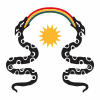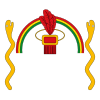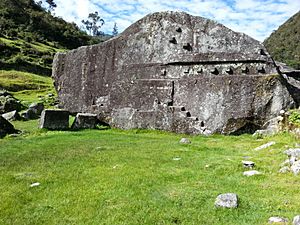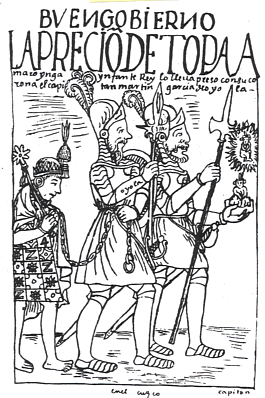Neo-Inca State facts for kids
Quick facts for kids
Realm of the Four Parts
(Neo-Inca State) Tawantinsuyu (Quechua)
|
|||||||||||
|---|---|---|---|---|---|---|---|---|---|---|---|
| 1537–1572 | |||||||||||
|
Banner reconstructions of the Sapa Inca
|
|||||||||||
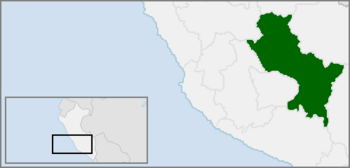
Modern Region of Cusco within Peru; the limits of the Neo-Inca State are unclear
|
|||||||||||
| Status | Independent state in Vilcabamba Vassal of the Spanish Empire (1567–1571) |
||||||||||
| Capital | Vilcabamba, Peru | ||||||||||
| Common languages | Quechua | ||||||||||
| Religion | Inca religion, Roman Catholicism | ||||||||||
| Government | Monarchy | ||||||||||
| Sapa Inca | |||||||||||
|
• 1537–1544
|
Manco Inca Yupanqui | ||||||||||
|
• 1545–1560
|
Sayri Túpac | ||||||||||
|
• 1563–1571
|
Titu Cusi | ||||||||||
| Historical era | Early modern | ||||||||||
|
• Manco Inca Yupanqui created the Neo-Inca state of Vilcabamba
|
1537 | ||||||||||
|
• Treaty of Acobamba
|
1566 | ||||||||||
|
• Spanish conquest led by Francisco de Toledo
|
1572 | ||||||||||
|
|||||||||||
| Today part of | Peru | ||||||||||
The Neo-Inca State, also called the Neo-Inca state of Vilcabamba, was an Inca kingdom. It was started in 1537 by Manco Inca Yupanqui in a place called Vilcabamba. Manco Inca was the son of the Inca emperor Huayna Capac.
This new state was like a small part of the huge Inca Empire (1438–1533). The main Inca Empire had fallen apart after the Spanish took over Peru in the mid-1530s. The Neo-Inca State lasted until 1572. That's when the Spanish conquered the last Inca stronghold. The last ruler, Túpac Amaru (Manco's son), was captured and executed. This brought an end to the Inca's political power.
Contents
The Neo-Inca State: A Last Stand
The Inca Retreat to Vilcabamba
The Vilcabamba area had been part of the Inca Empire for a long time. It was added during the rule of Pachacuti (1438–1471). During the Spanish conquest of Peru, the Spanish conqueror Francisco Pizarro made Túpac Huallpa a puppet ruler. This means Túpac Huallpa was in charge, but the Spanish controlled him.
After Túpac Huallpa died, Manco Inca Yupanqui joined Francisco Pizarro and Diego de Almagro. Pizarro's group arrived in Cusco, the Inca capital. There, Pizarro had the local leaders recognize Manco as their new Inca ruler. Manco Inca then helped Almagro and Hernando de Soto chase after an Inca general named Quizquiz.
Manco Inca's Fight for Freedom
When Pizarro left Cuzco, he left his younger brothers, Gonzalo Pizarro and Juan Pizarro, in charge. They treated Manco Inca very badly. Because of this, Manco Inca tried to escape in 1535. He failed and was put in prison.
Later, Hernando Pizarro let Manco Inca go. He wanted Manco to find a golden statue of his father, Huayana Capac. Manco was only with two Spaniards, so he easily escaped a second time. Manco then gathered a huge army of 100,000 Inca warriors. They started to attack Cusco in early 1536. This happened while Diego de Almagro was away.
After ten months of fighting (known as the Siege of Cuzco), Manco's army moved back. They went to the nearby fortress of Ollantaytambo in 1537. Here, Manco successfully fought off Spanish attacks in the Battle of Ollantaytambo.
Moving to the Jungle Fortress
Manco also planned an attack on Lima, led by one of his captains, Quiso Yupanqui. The Inca forces defeated four Spanish groups sent from Lima. This caused the death of almost 500 Spanish soldiers. Some Spaniards were captured and sent to Ollantaytambo.
However, the Spanish position became stronger when Almagro's soldiers arrived. Manco Inca decided that Ollantaytambo was too close to Cusco to be safe. So, he moved further west. Manco Inca left Ollantaytambo and the highlands of the empire. He retreated to Vitcos and then to the remote jungles of Vilcabamba.
Living Alongside the Spanish
In Vilcabamba, Manco established the Neo-Inca State. Vilcabamba became its capital. Manco continued to attack the Wankas, who were allies of the Spanish. He had some success after tough battles. He also fought in the highlands of present-day Bolivia, but his army was defeated there.
After many guerrilla battles in the mountains of Vilcabamba, Manco was killed in 1544. He was killed by supporters of Diego de Almagro. These men had previously killed Francisco Pizarro and were hiding under Manco's protection. Manco's soldiers then killed all of them.
Manco's son, Sayri Túpac (Sayri Tupaq), became the next Inca ruler. He was only five years old at the time. He ruled in Vilcabamba for ten years with the help of older advisors. This was a time of peace with the Spanish.
The Spanish Viceroy Pedro de la Gasca offered Sayri Túpac land and houses in Cuzco. He said Sayri Túpac could have them if he left the isolated Vilcabamba. Sayri Túpac agreed, but then his relative Paullu Inca suddenly died. This was seen as a bad sign, so Sayri Túpac stayed in Vilcabamba.
In 1557, Sayri Túpac did agree to leave Vilcabamba. He traveled to meet Viceroy Hurtado in Lima. Sayri Túpac gave up his claim to the Inca Empire. He also became a Christian, taking the name Diego. In return, he received a full pardon, the title of Prince of Yucay, and large lands with good income. He lived in Yucay, a day's journey northeast of Cuzco. He left behind the royal red fringe, which was a symbol of his power.
Titu Cusi and New Talks
In 1561, Sayri Túpac died suddenly. His half-brother Titu Cusi Yupanqui then took control of Vilcabamba. He also led the Inca resistance against the Spanish. During his rule, the Spanish governor-general Lope Garcia de Castro wanted to talk with him.
The talks were about Titu Cusi leaving Vilcabamba and accepting money from the Spanish Crown. After many discussions, around 1568, Titu Cusi was baptized into the Roman Catholic Church. He took the name Diego de Castro.
Túpac Amaru: The Final Inca Leader
Túpac Amaru became the Inca ruler after Titu Cusi's sudden death in 1571. At this time, the Spanish did not know that the previous Sapa Inca (Titu Cusi) had died. They sent two messengers to continue the talks with Titu Cusi. But these messengers were killed by an Inca captain at the border.
The new Viceroy, Francisco de Toledo, Count of Oropesa, used this as a reason to attack. He said the Incas had "broken the law about messengers." So, he decided to attack and conquer Vilcabamba. He declared war against the Neo-Inca State on April 14, 1572.
The End of the Neo-Inca State
Within two weeks of the war being declared, a small group of Spanish soldiers captured a key bridge. This bridge was on the border of the Neo-Inca State. From there, Toledo gathered his army. On June 1, the first battle of the war began in the Vilcabamba valley.
The Inca soldiers fought bravely at first, even though they did not have good weapons. The Inca tried many times to break the Spanish siege, but they had to retreat. On June 23, the fort of Huayna Pucará surrendered to Spanish cannons.
The Inca army was now retreating. They decided to leave their last city and go into the jungle to regroup. On June 24, the Spanish entered Vilcabamba. They found it empty, and the Sapa Inca was gone. The city had been completely destroyed. The Neo-Inca State officially ended. Túpac Amaru was later captured and executed by the Spanish.
How the Incas Learned Spanish Warfare
The Inca military quickly learned to use European weapons. Many warriors captured helmets, shields, and swords during early fights. They quickly learned how to use them. Unlike some other Native American groups, like the Aztecs, the Incas were eager to learn about weapons that were completely new to them.
As early as 1537, when Manco Inca defeated the Spanish at Pilcosuni, the Incas got more advanced Spanish weapons. These included arquebuses (early guns), cannons, and crossbows. By the later parts of the Siege of Cusco, the Spanish reported that Inca warriors were using captured firearms and horses quite well. Manco Inca even forced captured Europeans to make gunpowder for his army.
The Incas also tried to use some European battle plans. At least once, a group of Inca warriors formed a tight fighting unit. They learned this from a captured Spaniard. They used their bows, slings, and darts to shoot faster. In 1538, Manco Inca was skilled enough to ride a horse into battle. At this point, he and three of his nobles even led a cavalry charge. This charge destroyed a group of 30 Spanish foot soldiers. However, the Incas were still not perfect at using some modern weapons. A writer named Pedro Pizarro reported that Inca gunners often had their guns misfire. In the battles from 1536 to 1538, the captured weapons did not make a big difference.
In the early 1540s, several Spanish refugees taught Inca warriors how to use Spanish weapons to their full potential. Overall, it took the Incas about twenty years to catch up with the Spanish in terms of technology. By the 1560s, many Incas had become very skilled at using arquebuses and riding horses.
See also
 In Spanish: Estado neoincaico para niños
In Spanish: Estado neoincaico para niños


